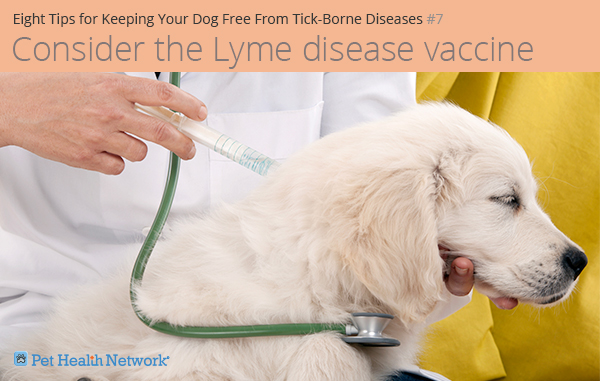Ticks are such annoying little creatures, but far more significant than the nuisance factor is their ability to spread disease. Ticks that embed in a dog’s skin can transmit a variety of serious and even life threatening infectious diseases including:
Another problem ticks can cause is a rare neurological condition called “tick paralysis.” Lastly, ticks can produce inflammation and bacterial infection right at the site of the bite.
Prevention strategies
Prevention is the golden rule when it comes to keeping your dog free from tick-borne diseases. Here are eight tried and true tips to accomplish this:
While ticks are prevalent throughout North America, and year-round tick prevention is recommended, the time of year they are most problematic varies from region to region. Ask your veterinarian when tick season occurs in your neck of the woods. This will be the time of year to be most vigilant with tick control measures.
[Ticks don’t go away just because it’s cold. Learn about ticks and fall here.]
Ticks prefer areas with dense vegetation. Much of their time is spent on the ground, but they are adept at crawling up to the tips of shrubs and grasses. This vantage point enhances their ability to successfully leap onto an animal passing by. Best to avoid exposing your dog to such shrubby and grassy areas, particularly during peak tick season.
[Learn about ticks hiding in leaves here.]
There are a variety of products on the market that prevent and/or kill ticks. Some tick collars work well, but are not a good choice for dogs who do a lot of swimming or those who have “mouthy play” with other dogs (chemicals within the collar might be ingested by your dog’s playmate).
Other tick-prevention options include monthly medication administered orally or applied topically (to the skin). There are a variety of products to choose from and most are combined with flea prevention medication. Talk with your veterinarian about which tick prevention products make the most sense for your dog.
Perform a “tick check” on your dog daily, particularly following outdoor excursions. Getting rid of the little buggers before they’ve had a chance to embed eliminates the possibility of disease transmission. The ticks’ favorite places to attach are your dog’s neck, head and ears, so pay particularly close attention to these areas.
[See how to check your dog for ticks here.]
Sounds gross, I know, but saving the ticks you remove just might prove to be useful. Different species of ticks transmit different diseases. Given that symptoms of the various tick-borne diseases overlap, having knowledge of the type of tick your dog was exposed to may help your veterinarian hone in on a diagnosis more expediently. I recommend dunking and storing the ticks in a disposable container filled with isopropyl alcohol. Show them to your veterinarian should your dog become sick.
Do your best to remove any embedded ticks as soon as possible. Less time spent attached to your dog lessens the odds of disease transmission.
You’ll find dozens of recommendations online describing how to remove an embedded tick. Be wary of what you read. Burning a tick with a hot match is not effective, and you risk singeing your dog’s haircoat. Coating the tick with Vaseline® or some other type of lubricant does nothing but render the tick slippery and more difficult to remove. And acetone, such as the chemical found in nail polish removers, causes the tick to become brittle and more likely to shatter during the removal process.
Talk with your veterinarian about preferred methods for removing embedded ticks. Whichever method you choose, be sure to wear gloves so as to eliminate any risk of disease transmission for yourself.
[Learn how to safely remove a tick here.]
The Lyme disease vaccine has been available now for several years. Most veterinarians who specialize in infectious diseases continue to recommend against vaccinating dogs who do not live in areas where there is a high incidence of Lyme disease. Additionally, there is lack of agreement about exactly how much protection the vaccine provides. Discussion with your veterinarian on this topic is certainly warranted.
[Learn more about vaccines for adult dogs here.]
Rest assured that the majority of dogs exposed to ticks never develop a tick-borne disease. But for those who do, early recognition of symptoms, quickly arriving at a diagnosis, and prompt treatment by your veterinarian enhance the likelihood of a positive outcome. If your dog has tick exposure, talk with your veterinarian about what symptoms you should be on the look out for.
Questions for your veterinarian
- When does tick season occur here?
- Which tick prevention products do you recommend for my dog?
- What method of tick removal do you recommend?
- Does the Lyme disease vaccination make sense for my dog?
- What are the symptoms of tick-borne disease that I should be watching for?
If you have any questions or concerns, you should always visit or call your veterinarian -- they are your best resource to ensure the health and well-being of your pets.








